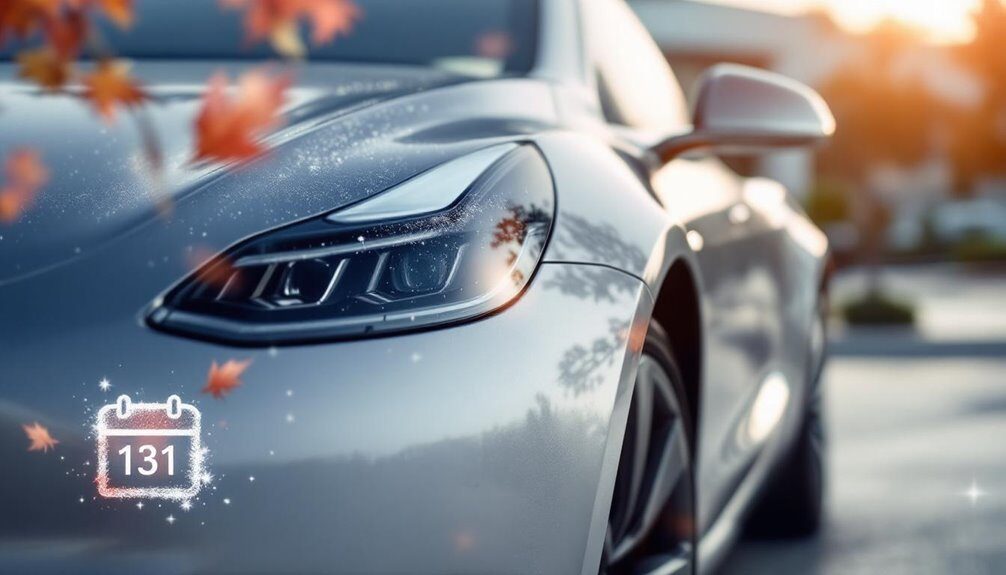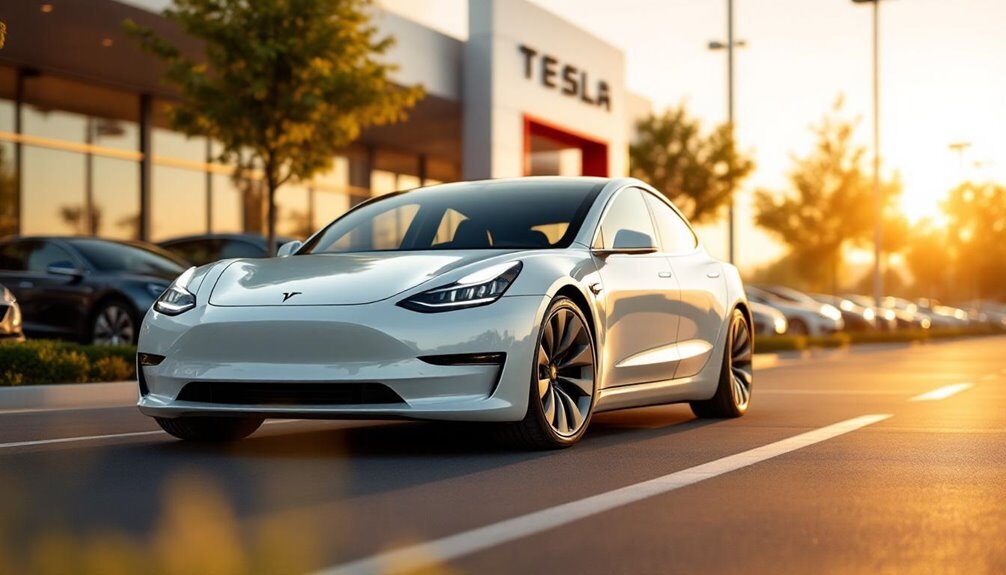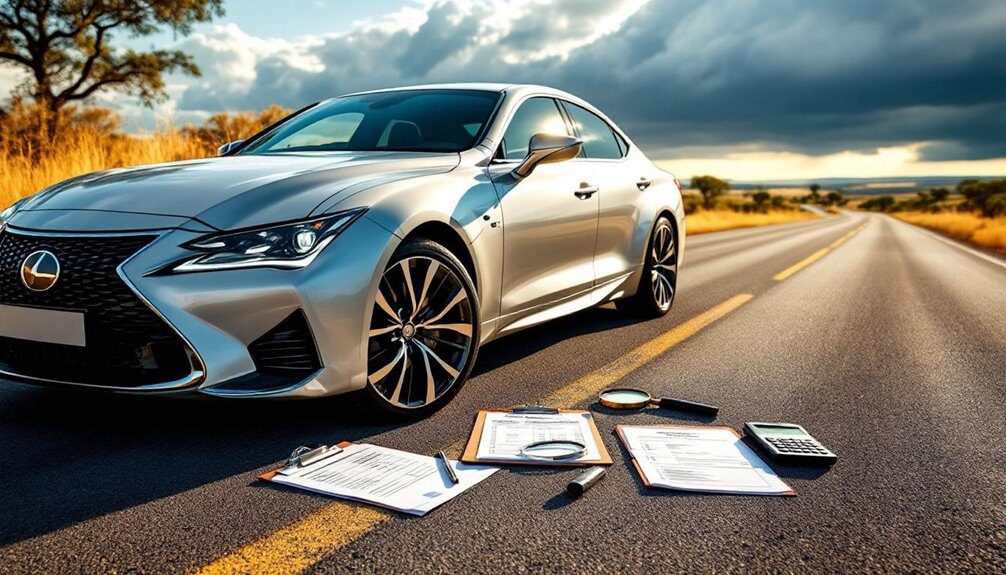Your Toyota Hilux, Volkswagen Polo Vivo, and Ford Ranger aren’t just reliable workhorses—they’re hijacker magnets. South Africa’s hitting roughly 65 carjackings daily, with Gauteng, the Western Cape, and KwaZulu-Natal leading the charge. Luxury rides like the BMW 3 Series and Mercedes-Benz C-Class? Also prime targets. Criminals want your engine, transmission, and electronics on the black market. Peak danger windows hit Friday afternoons through Saturday nights, plus morning rush hours. Keep digging to reveal what actually stops these criminals cold.
Toyota Hilux: The Prime Target for Vehicle Hijackers
Regarding vehicle hijackings in South Africa, there’s one name that keeps popping up on crime statistics year after year: the Toyota Hilux. And honestly? It’s not hard to see why.
You’ve got a vehicle that’s durable, reliable, and wildly popular across industries—agriculture, construction, you name it. That means consistent demand. The diesel variants like the GD6 and D4D? Even more targeted. Their sturdy engines have serious black-market value, especially across borders.
Then there’s the design itself. Easy to strip for parts. High ground clearance perfect for illegal uses. Mechanical simplicity compared to modern cars with fancy security systems. The widespread use in urban and rural areas means criminals encounter Hilux vehicles far more frequently than other models, making them statistically easier targets.
Over 5,400 hijackings hit just one quarter recently, with the Hilux leading the pack. Daily averages exceed 50 vehicles nationwide. Ctrack hijacking statistics consistently rank the Toyota Hilux as the most targeted commercial vehicle across South Africa’s crime data.
Volkswagen Polo Vivo: Accessibility and Parts Value Drive Demand
Whilst the Toyota Hilux dominates hijacking statistics, there’s another vehicle that’s consistently making criminals’ wish lists: the Volkswagen Polo Vivo.
You’ve probably noticed them everywhere—taxis, Uber drivers, families. That popularity? It’s exactly why hijackers love them. Locally built at VW’s Kariega plant, the Polo Vivo’s parts are ridiculously accessible. Simple engineering. Affordable components. A massive dealership network across South Africa. Basically, criminals know they can strip these cars and move parts fast. The Polo Vivo’s proven reliability and durable engineering combined with its affordability make it particularly attractive to those seeking quick returns on stolen vehicle components. For legitimate owners needing replacements, the extensive inventory of genuine OEM parts available through local suppliers ensures repairs remain affordable and straightforward. Regular tyre maintenance and inspections can help owners maintain their vehicle’s condition and deter potential thieves who target poorly maintained vehicles.
| Why Hijackers Target It | What Makes It Easy | The Real Cost |
|---|---|---|
| High resale value | Widely available parts | Strong demand from thieves |
| Strong brand reputation | Affordable servicing | Popular commuter profile |
| Fuel efficiency appeal | Durable design | Standardised theft methods |
Here’s the uncomfortable truth: the Polo Vivo’s greatest strengths—reliability, affordability, parts availability—make it a criminal’s dream target.
Ford Ranger and Nissan NP200: Popular Utility Vehicles Under Threat
You’re driving a Ford Ranger or Nissan NP200—congratulations, you’re now operating one of South Africa’s most sought-after targets for hijackers.
These workhorses tick every box criminals need: reliable performance, prized parts that strip quick, and enough commercial demand to vanish into the black market before you’ve even called your insurance company.
If you’re in the market for a safer alternative, consider exploring used vehicles from reputable dealers that prioritise vehicle security and offer nationwide delivery options for added peace of mind. Regular vehicle inspections and routine maintenance checks can also help identify security vulnerabilities before they become liabilities.
Why Hijackers Target Them
The Ford Ranger and Nissan NP200 aren’t hijacked because they’re rare or fancy—they’re targeted because they’re everywhere.
You see them daily. On your commute. At job sites. Parked outside shops. Hijackers know this. They exploit predictable routines and familiar parking spots.
Your commercial use? It makes you an easier mark. These vehicles blend seamlessly into work environments, reducing suspicion.
The real kicker: their parts are gold. Stripped Ranger and NP200 components move fast through informal markets—locally and across borders. Criminals dismantle them quickly for immediate profit.
Plus, both vehicles handle cargo and rough terrain, making them prized for illegal operations beyond simple resale. The demand’s unrelenting. Eswatini. Mozambique. Neighbouring countries pay premium prices for smuggled units. If you’re concerned about vehicle security in high-risk areas like Paulpietersburg and eDumbe, comprehensive automotive care providers can advise on protective measures.
You’re not dealing with random targeting here. It’s calculated. Strategic. Opportunity meeting vulnerability.
When purchasing a vehicle, reliable automotive care and professional inspection through trusted dealers can help you avoid high-risk models and make informed decisions about your investment.
Protection Strategies for Owners
Owning a Ford Ranger or Nissan NP200 in South Africa means accepting a hard truth: your vehicle’s a target. Hijackers know these bakkies’ value. So you’ve got to fight back.
| Protection Layer | What It Does | Why It Matters |
|---|---|---|
| Physical Security | Immobilisers, alarms, steering locks | Makes hijacking harder, costlier |
| Tracking Tech | GPS devices, monitoring apps | Enables recovery post-theft |
| Smart Parking | Well-lit areas, secure zones | Reduces opportunity windows |
| Insurance Coverage | Hijacking-specific policies | Protects your investment |
Skip the predictable routines. Lock doors religiously. Install tracking devices. Register with recovery services. Stay alert at traffic lights—that’s hijacker prime time. Update security details with insurers regularly. Professional technicians can inspect your electrical system repairs to verify all security components function correctly. Consider scheduled maintenance services to ensure your vehicle’s security systems remain fully functional. Your bakkie’s under siege, but you’re not defenceless.
Toyota Corolla Cross and Corolla Quest: Rising Hijacking Incidents
Increasingly, criminals are zeroing in on Toyota Corolla Cross and Corolla Quest models—and for good reason. The Corolla Cross debuted in 2021, rocketed to second place nationally by 2025, and now hijackers can’t get enough of it. Why? It’s inconspicuous. White or silver versions blend seamlessly into traffic. Easy to manoeuvre in city chaos. Massive resale and parts demand on the black market.
The Corolla Quest faces similar heat, especially in taxi and fleet operations. You’re basically rolling in a target when you drive these vehicles daily. Organised groups follow victims home, jam electronics, and strike at intersections and driveways. KwaZulu-Natal sees constant incidents. Gauteng’s a nightmare zone. These aren’t random crimes—they’re calculated, systematic operations feeding black market economies and cross-border smuggling rings.
Luxury Vehicles: BMW 3 Series and Mercedes-Benz C-Class Appeal
You’re looking at luxury cars that criminals can’t resist—the BMW 3 Series and Mercedes-Benz C-Class aren’t just targets because they’re fancy, they’re goldmines for parts that move fast on black markets, both locally and overseas where premium components fetch serious money.
Organised gangs know exactly what they’re after: they’ll strip these vehicles for high-demand parts or ship the whole thing abroad, banking on the relentless demand for luxury components that keeps resale prices climbing.
What makes it worse is that cross-border networks have turned these cars into international commodities, meaning your stolen 3 Series could be dismantled in a chop shop or heading towards a shipping container within hours.
High-Value Parts Demand
Regarding luxury car hijackings in South Africa, the BMW 3 Series and Mercedes-Benz C-Class don’t just sit pretty—they’re basically painted targets. Here’s why: their parts are gold on the black market. We’re talking serious money.
| Component | Market Value | Demand Level | Risk Factor | Buyer Pool |
|---|---|---|---|---|
| Engines | Premium | Very High | Critical | Local/International |
| Transmissions | High | Very High | Critical | Organised Syndicates |
| Infotainment Systems | Medium-High | High | Raised | Underground Networks |
| Electronic Components | High | Very High | Critical | Parts Dealers |
| Interior Trim | Medium | Moderate | Moderate | Resellers |
Criminals dismantle these vehicles systematically. Engines fetch thousands. Transmissions? Even more. The tech components—infotainment, driver assistance systems—they’re scarce, making them incredibly prised. Luxury vehicle owners aren’t just losing cars; they’re losing walking ATMs. Organised crime groups know this. They hunt these models persistently. Maintaining detailed service records through regular inspections helps owners document their vehicle’s condition and may significantly aid in recovery efforts and insurance claims. Regular routine maintenance services can help owners document their vehicle’s condition and maintain detailed service records, which may aid in recovery efforts and insurance claims.
Cross-Border Resale Markets
Across South Africa’s borders, stolen BMWs and Mercedes aren’t just disappearing—they’re turning into cash machines for organised crime.
Here’s the thing: these luxury saloons command 2-3 times higher resale prices in neighbouring countries than they’d fetch locally. Criminal networks have basically weaponised this price gap. They’ve got established smuggling routes through Botswana, Zimbabwe, and Mozambique—vehicles can cross borders in 24-48 hours, clean paperwork and all.
The demand’s real too. Middle-class expansion in regional markets means wealthier buyers crave European prestige symbols. Currency disparities make stolen luxury vehicles irresistible investments for professional buyers. Taxi operators, government officials, business elites—they’re all potential customers.
It’s a perfectly orchestrated system: hijack, forge documents, transport, profit.
Targeted Theft Methods
Criminal networks have zeroed in on the BMW 3 Series and Mercedes-Benz C-Class for one simple reason: they’re security goldmines wrapped in luxury appeal. You’re looking at vehicles that thieves actually study. Here’s why they’re so attractive:
- Security systems designed for “legitimate access” are ironically exploitable by criminals
- Components command premium prices domestically and internationally—serious money
- Parts interchange across model years, multiplying their resale value
- Organised syndicates employ scouts tracking high-value targets systematically
These luxury saloons aren’t random targets. Criminal networks know demand signals. They grasp which models fetch maximum prices on resale markets.
You’ve got scouts identifying vehicles. You’ve got calculated targeting strategies. The BMW 3 Series hijacking rates? They’re reportedly higher than comparable categories. That’s not coincidence—it’s business.
Geographic Hotspots: Where Hijackings Occur Most Frequently
Regarding vehicle hijackings in South Africa, geography isn’t just a detail—it’s everything. You’re looking at Gauteng as the primary hotspot. Johannesburg, Soweto, Pretoria West? Yeah, those are hijacking capitals. Then there’s the Western Cape‘s emerging threat. Cape Town’s Nyanga, Mitchells Plain, Khayelitsha recorded 1,613 carjackings in just six months during 2024.
KwaZulu-Natal’s no joke either—Durban, Umlazi, Phoenix. That’s 1,512 carjackings in the same period.
But here’s the kicker: Mpumalanga’s becoming the new player. Hijackings there happen three times more often than thefts. eMalahleni’s climbing the charts fast. Traffic congestion, poor lighting, predictable commuter routes—carjackers know exactly where you’ll be. Your driveway between 5–8 PM? Prime target.
Peak Risk Times: When Hijackers Strike
- Friday afternoons (4pm-9pm) — Peak hijacking window. You’re relaxed. They’re ready.
- Friday-Saturday evenings (9pm-midnight) — Extended danger zone as weekend leisure travel kicks in.
- Morning rush (6am-8am) — Your commute isn’t safe either. Driver distraction = criminal opportunity.
- Load shedding hours — When power fails, so does traffic management. Darkness becomes their ally.
Tuesday and Friday between 4pm-8pm? Consistently brutal.
Wednesday through Friday evenings maintain steady danger.
Approximately 65 vehicles get hijacked daily across South Africa.
The maths is grim. The timing’s clear. You’re either aware or you’re vulnerable.
Common Hijacking Methods and Tactics Used by Criminals
Hijackers don’t just roll up and demand your keys—they’re far more calculated than that. They’ve got a playbook, and it’s disturbingly effective.
Hijackers operate with calculated precision, employing a sophisticated playbook that’s disturbingly effective at targeting unsuspecting drivers.
Some use fake uniforms and bogus roadblocks to trap you into stopping. Others throw paint on your windscreen or slash your tyres, forcing you out of the vehicle.
The really organised ones? They’re jamming your car’s locking system in car parks, making it impossible to secure your ride.
Then there’s the online angle—criminals posing as buyers on Facebook Marketplace, luring you to sketchy meetups.
Physical intimidation’s common too: ramming, weapons, threats. They work in teams to maximise control and minimise your chances of fighting back. It’s coordinated, aggressive, and increasingly sophisticated.
Vulnerable Vehicle Types Beyond Individual Models
You’re not just dealing with specific car models anymore—whole vehicle categories have become criminal goldmines.
Commercial bakkies and utility vehicles face relentless targeting in areas with weak law enforcement, whilst saloons and hatchbacks remain popular hits because they’re everywhere, making stolen units blend right back into traffic.
Then there’s the luxury parts angle: you’ve got buyers willing to pay serious cash for expensive, easily removable components like catalytic converters and premium infotainment systems, which means criminals aren’t always after your whole car—just the precious bits bolted onto it.
Commercial Vehicles High Target
While individual car models grab the headlines, South Africa’s real hijacking crisis isn’t about whether you’re driving a Toyota or a Ford—it’s about what you’re *carrying*. Commercial vehicles face persistent targeting. Here’s why you should care:
- Light delivery vans like Toyota Quantums and Ford Transits are constant targets due to cargo capacity
- Panel vans and bakkies used commercially are hijacked for resale or criminal operations
- Refrigerated trucks transporting perishables are vulnerable—predictable routes, valuable goods
- Cargo trucks hauling food, beverages, pharmaceuticals, and electronics face systematic attacks
These aren’t random incidents. Criminals operate systematically across Gauteng, Eastern Cape, and Western Cape corridors.
Major highways connecting ports and industrial hubs? Dangerous zones. Distribution centres? Crime hotspots. If your business relies on commercial freight, you’re navigating a genuinely risky terrain.
Saloon and Hatchback Vulnerability
Saloons and hatchbacks aren’t just popular—they’re *everywhere*, which is exactly why they’re hijacking targets. During Q4 2024/2025, these vehicles accounted for 44.4% of all hijacking incidents. You’re driving what criminals want. The VW Polo Vivo and Toyota Corolla? Top targets. Why? Strong aftermarket value. Easy parts stripping. High volume means more opportunities for crooks.
| Vehicle Type | Why Targeted | Criminal Appeal | Your Risk |
|---|---|---|---|
| VW Polo Vivo | Wide circulation | Parts stripping ease | Extremely high |
| Toyota Corolla | Mass popularity | Resale demand | Extremely high |
| Saloon/Hatchback | Everyday usage | Predictable patterns | Very high |
| Fleet vehicles | Known routes | Vulnerable parking | High |
Their older security technology and smaller size make hijacking straightforward. Urban hotspots like Johannesburg and Durban see concentrated activity. Criminals adjust fast—newer models get targeted as they gain traction.
Luxury Parts Market Appeal
Luxury cars aren’t just status symbols—they’re cash machines for hijackers. You’re looking at vehicles that criminals actively strip for parts worth serious money on the black market.
Here’s what makes them so attractive:
- Genuine replacement parts command premium prices due to luxury build quality
- Electronic modules, alloy wheels, and infotainment systems fetch substantial resale value
- BMW 3 Series, Audi A4, and Mercedes-Benz C-Class models are hijacking favourites
- Complex electronics are harder to counterfeit, making them ideal for underground markets
The reality? Theft gangs don’t always need your whole car. They want those high-tech components.
Your luxury vehicle’s sophisticated systems—the ones you paid extra for—make it a target. The underground market for these parts sustains itself through persistent demand. That’s why your fancy ride’s appeal extends far beyond the showroom.
Essential Protection Strategies to Prevent Vehicle Hijacking
Because vehicle hijacking remains a persistent threat across South Africa—especially in the Eastern Cape and Western Cape where incidents climb 30% and 17% year-on-year respectively—you’ve got to take protection seriously.
Vehicle hijacking surges 30% in Eastern Cape, 17% in Western Cape. Protection isn’t optional—it’s essential.
Install GPS tracking and immobiliser systems. They let you recover your vehicle quickly or disable it remotely if hijackers grab it.
Physical barriers matter too. Steering wheel locks, gear locks, pedal locks—they’re annoying for criminals and buy you time.
Smart alarms with audio and visual deterrents discourage attackers.
Keep doors locked at traffic lights. Windows up. Don’t chat with strangers approaching your window.
Use mapped safe routes, skip shortcuts.
Update your vehicle’s security software regularly to block hacking attempts.
Stay alert. Stay alive.




